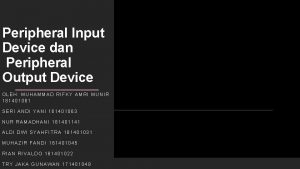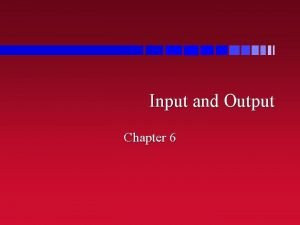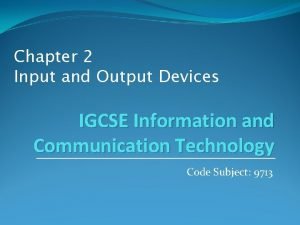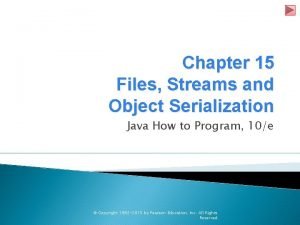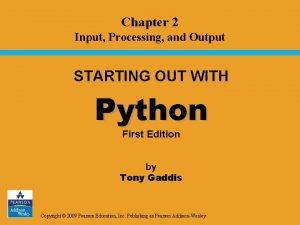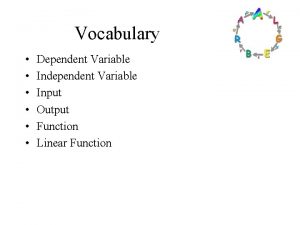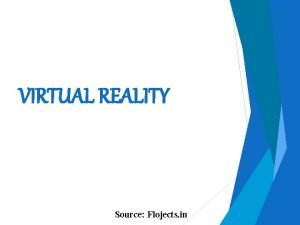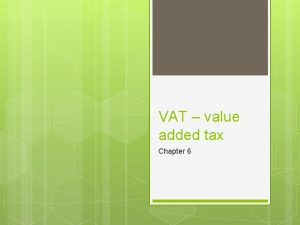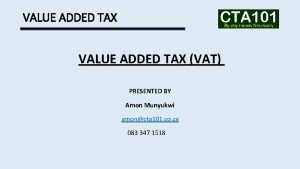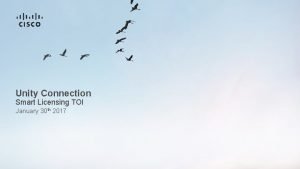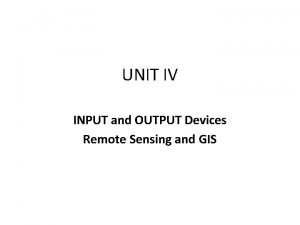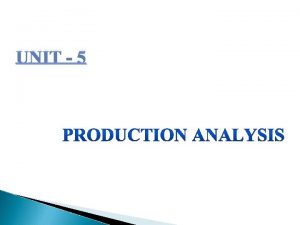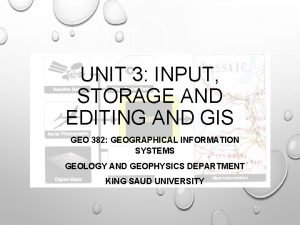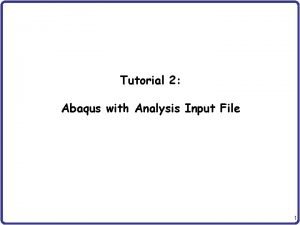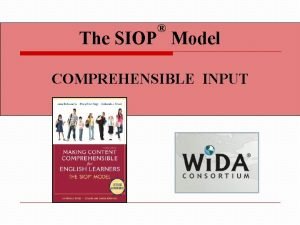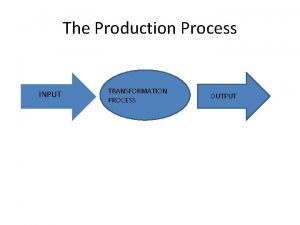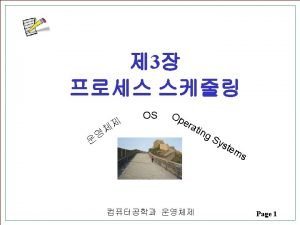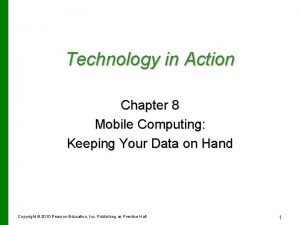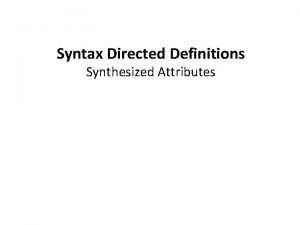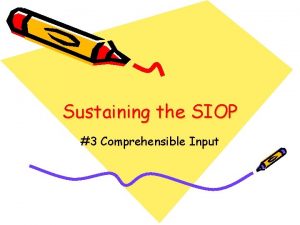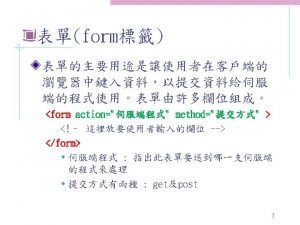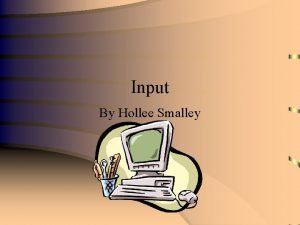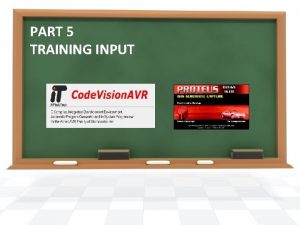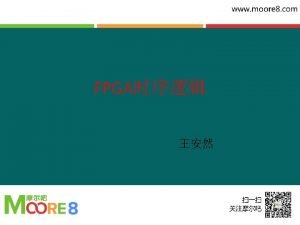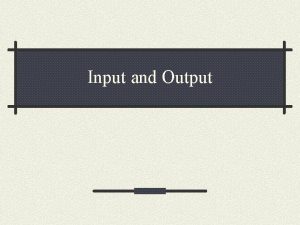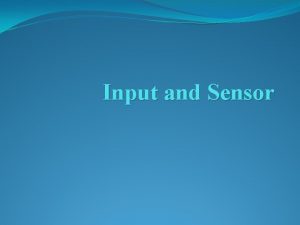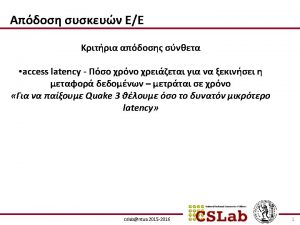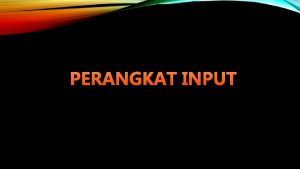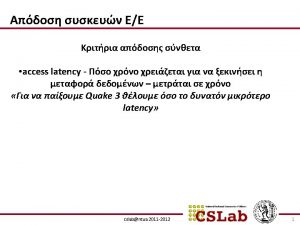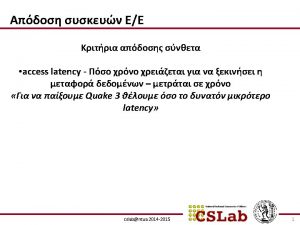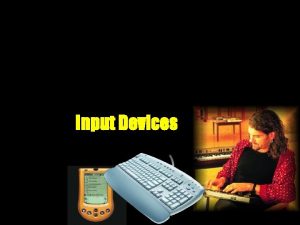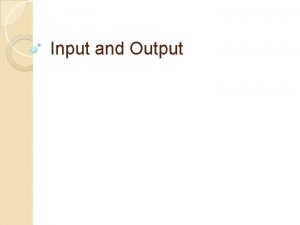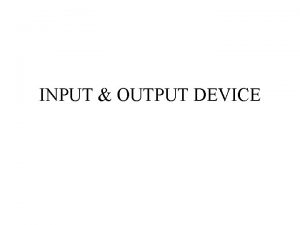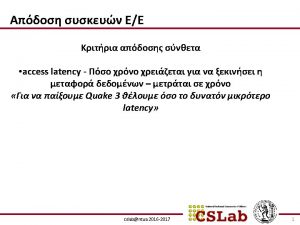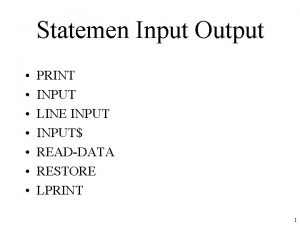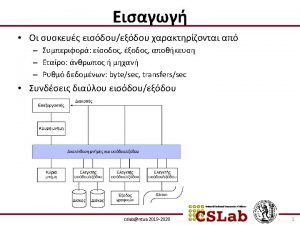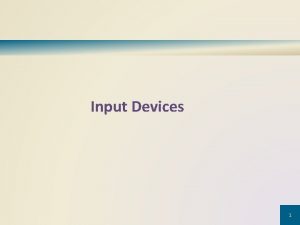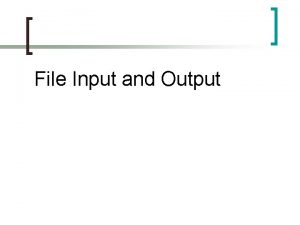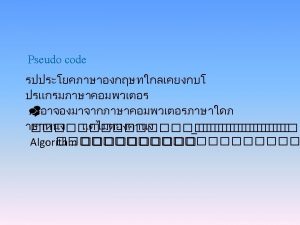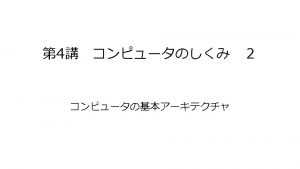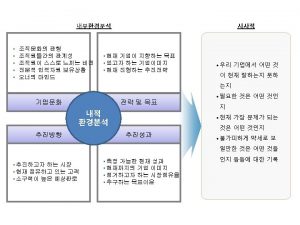Chapter 5 Input What Is Input What is











































- Slides: 43

Chapter 5 Input

What Is Input? What is input? Ø Data or instructions entered into memory of computer Ø Input device is any hardware component that allows users to enter data and instructions p. 234 and 236 Fig. 5 -1 Next

What Is Input? What are the two types of input? Ø Data § Ø Instructions § § § p. 234 Unprocessed text, numbers, images, audio, and video Programs Commands User responses Next

The Keyboard How is the keyboard divided? Ø Ø Ø Typing area Numeric keypad Function keys, special keys that issue commands p. 236 Fig. 5 -2 Next

The Keyboard What is the insertion point? Ø Ø Blinking vertical bar that indicates where next character you type will display Pointer changes location and shape as you move mouse or other pointing device p. 237 Fig. 5 -3 Next

The Keyboard What is a cordless keyboard? Ø Communicate with a receiver attached to a port on the system unit p. 238 Fig. 5 -4 Next

Pointing Devices What is a mouse? Ø Pointing device that fits under palm of hand § Ø Pointing device controls movement of pointer, also called mouse pointer mouse buttons wheel button Mechanical mouse has rubber or metal ball on underside ball mouse pad p. 239 Fig. 5 -5 Next

Pointing Devices What is an optical mouse? Ø Ø No moving mechanical parts inside Senses light to detect mouse’s movement More precise than mechanical mouse Connects using a cable, or wireless p. 239 Fig. 5 -6 Next

Pointing Devices What are common mouse operations? Point p. 240 Fig. 5 -7 Click Doubleclick Drag Rightdrag Rotate wheel Press wheel button Tripleclick Rightclick Tilt wheel Next

Other Pointing Devices What is a trackball? Ø Ø Stationary pointing device with a ball on its top or side To move pointer, rotate ball with thumb, fingers, or palm of hand p. 241 Fig. 5 -8 Next

Other Pointing Devices What are a touchpad and a pointing stick? Ø Ø Touchpad is small, flat, rectangular pointing device sensitive to pressure and motion Pointing stick is pointing device shaped like pencil eraser positioned between keys on keyboard p. 241 - 242 Figs. 5 -9— 5 -10 Next

Other Pointing Devices What are a joystick and a wheel? Ø Ø Joystick is vertical lever mounted on a base Wheel is steering-wheel-type input device § p. 242 Fig. 5 -11 Pedal simulates car brakes and accelerator Next

Other Pointing Devices What is a control pad and a gamepad? Ø Ø Control pad on an audio player allows users to scroll through music, adjust volume, and customize settings Gamepad a pointing device that controls the movement and actions of players or objects in games p. 242 Fig. 5 -12 Next

Other Pointing Devices What is a light pen? Ø Handheld input device that can detect light § p. 242 Press light pen against screen surface and then press button on pen Next

Other Pointing Devices What is a touch screen? Ø Ø Touch areas of screen with finger Often used with kiosks p. 243 Fig. 5 -13 Next

Keyboard and Pointing Devices What is a stylus and a digital pen? Ø Ø Looks like a ballpoint pen, but uses pressure to write text and draw lines Used with graphics tablets, flat electronic boards p. 243 - 244 Fig. 5 -14 and 5 -15 Next

Voice Input How does voice recognition work? p. 245 Fig. 5 -18 Next

Voice Input What is a MIDI (musical instrument digital interface)? Ø External device, such as electronic piano keyboard, to input music and sound effects p. 246 Fig. 5 -19 Next

PDAs, Tablet PCs, and Smart Phones How is data entered into a PDA? p. 247 Fig. 5 -20 Next

PDAs, Tablet PCs, and Smart Phones What is a portable keyboard and a docking station? A portable keyboard is a full-sized keyboard you conveniently attach to and remove from PDA Ø A docking station is an external device that holds a mobile computer Ø p. 248 Fig. 5 -21 Next

PDAs, Tablet PCs, and Smart Phones What is a smart phone? Ø Ø Users can input and send text messages, graphics, pictures, video clips, and sound files Many have a built-in or attachable camera p. 248 - 249 Fig. 522 Next

PDAs, Tablet PCs, and Smart Phones What is a Tablet PC? Ø Ø Mobile computer that includes handwriting recognition software Primary input device is a pressure-sensitive digital pen p. 249 – 250 Fig. 523 Next

Digital Cameras What is a digital camera? Ø Ø Allows you to take digital pictures Images viewable immediately on camera § § p. 250 Fig. 5 -24 Download to computer Post pictures to Web Next

Digital Cameras How does a digital camera work? p. 251 Fig. 5 -25 Next

Digital Cameras What is resolution? Ø Ø Ø Sharpness and clarity of image The higher the resolution, the better the image quality, but the more expensive the camera Pixel (picture element) is single point in electronic image § p. 252 Fig. 5 -26 Greater the number of pixels, the better the image quality Next

Video Input What is video input? Ø Ø Ø Process of entering full-motion images into computer Video capture card is adapter card that converts analog video signal into digital signal that computer can use Digital video (DV) camera records video as digital signals p. 253 Fig. 5 -27 Next

Video Input What is a PC video camera and a Web cam? Ø PC video camera — digital video camera used to capture video and still images, and to make video telephone calls on Internet c § Ø c Also called PC camera Web cam — video camera whose output displays on a Web page p. 253 Fig. 5 -28 c c Next

Video Input What is video conferencing? Ø Two or more geographically separated people who use network or Internet to transmit audio and video data § p. 254 Fig. 5 -29 Whiteboard is another window on screen that can display notes and drawings simultaneously on all participants’ screens Next

Scanners and Reading Devices Flatbed What is a scanner? Ø Light-sensing device that reads printed text and graphics § Used for image processing, converting paper documents into electronic images Pen or Handheld Sheet-fed Drum p. 255 Fig. 5 -30 Next

Scanners and Reading Devices How does a flatbed scanner work? Step 1: Place the document to be scanned face down on the glass window. Using buttons on the scanner or the scanner program, start the scanning process. Step 2: The scanner converts the document content to digital information, which is transmitted through the cable to the memory of the computer. p. 256 Fig. 5 -31 Step 3: Once in the memory of the computer, users can display the image, print it, e-mail it, include it in a document, or place it on a Web page. Next

Scanners and Reading Devices What is an optical reader? Ø Device that uses light source to read characters, marks, and codes and then converts them into digital data § § p. 257 Fig. 5 -32 Optical character recognition (OCR) reads characters in OCR font Optical mark recognition (OMR) reads hand-drawn pencil marks, such as small circles Next

Scanners and Reading Devices What is a turnaround document? Ø Document that you return to the company that sent it § p. 257 Fig. 5 -33 Portion you return has information printed in OCR characters Next

Scanners and Reading Devices What is a bar code reader? Ø Uses laser beams to read bar codes p. 258 Fig. 5 -34 Next

Scanners and Reading Devices What is a bar code? Ø Ø Identification code that consists of a set of vertical lines and spaces of different widths Universal Product Code (UPC) p. 258 Fig. 5 -35 Next

Other Input Devices What is an RFID reader? Ø Reads information on the tag via radio waves § p. 259 Fig. 5 -36 Can be handheld devices or mounted in a stationary object Next

Other Input Devices What is a magnetic stripe card reader? Ø Ø Reads the magnetic stripe on the back of a credit card Exposure to a magnetic field can erase the contents of a card’s magnetic stripe p. 260 Fig. 5 -37 Next

Scanners and Reading Devices What is a magnetic-ink character recognition (MICR) reader? Ø Ø Can read text printed with magnetized ink Banking industry almost exclusively uses MICR for check processing p. 260 Fig. 5 -38 Next

Scanners and Reading Devices What is a data collection device? Ø Ø Obtains data directly at location where transaction or event takes place Transmits data over network or Internet p. 261 Fig. 5 -39 Next

Terminals What is a point of sale (POS) terminal? Ø Records purchases, processes credit or debit cards, and updates inventory § § Swipe credit or debit card through card reader Reads customer’s personal data from magnetic strip p. 261 - 262 Fig. 540 Next

Terminals What is an automated teller machine (ATM)? Ø Self-service banking machine that connects to a host computer through a network p. 262 Fig. 5 -41 Next

Biometric Input What is biometrics? Ø Authenticates person’s identity by verifying personal characteristic § § Fingerprint scanner captures curves and indentations of fingerprint Hand geometry system measures shape and size of person’s hand p. 262 Fig. 5 -42 and 5 -43 Next

Biometric Input What are examples of biometric technology? Ø Ø Ø Voice verification system compares live speech with stored voice pattern Signature verification system recognizes shape of signature Iris recognition system reads patterns in blood vessels in back of eye § Biometric data is sometimes stored on smart card, which stores personal data on microprocessor embedded in card p. 263 – 264 Figs. 5 -44— 545 Next

Input Devices for Physically Challenged Users What input devices are available for those with physical limitations? Ø Ø Ø Keyguard allows users to rest hands on keyboard without accidentally pressing keys Head-mounted pointer controls pointer on screen New developments include gesture recognition and computerized implant devices p. 266 Figs. 5 -47 Next
 Peripheral output adalah... *
Peripheral output adalah... * Finely tuned input and roughly tuned input
Finely tuned input and roughly tuned input Chapter 6 input and output
Chapter 6 input and output Touch screen input and output
Touch screen input and output Chapter 15 input output java
Chapter 15 input output java Chapter 2 input processing and output
Chapter 2 input processing and output Red tent summary
Red tent summary What season is approaching the great gatsby chapter 8
What season is approaching the great gatsby chapter 8 Chapter 10 chemical reactions answer key
Chapter 10 chemical reactions answer key Chapter 11 stoichiometry test answer key
Chapter 11 stoichiometry test answer key Chapter 9 chemical reactions
Chapter 9 chemical reactions Ratio and proportion for use after section 7-2
Ratio and proportion for use after section 7-2 Chapter 6 career readiness review
Chapter 6 career readiness review 7 ionic and metallic bonding
7 ionic and metallic bonding Chapter 9 surface water answer key
Chapter 9 surface water answer key Physics chapter 2 representing motion assessment answers
Physics chapter 2 representing motion assessment answers Chapter 1 chapter assessment the central science
Chapter 1 chapter assessment the central science Chapter 7 ionic and metallic bonding assessment answer key
Chapter 7 ionic and metallic bonding assessment answer key Chapter 4 population ecology worksheet answer key
Chapter 4 population ecology worksheet answer key Chapter 2 chapter assessment
Chapter 2 chapter assessment Introduction to the book of philippians
Introduction to the book of philippians Ionic compounds
Ionic compounds Chapter 7 chapter assessment ionic compounds and metals
Chapter 7 chapter assessment ionic compounds and metals Representative metal
Representative metal Definition of work in physics
Definition of work in physics Dependent variable vs independent variable
Dependent variable vs independent variable Vr input
Vr input Vat input
Vat input Dremployee
Dremployee Vat input
Vat input Principles of input design
Principles of input design Cssm cisco
Cssm cisco Output device for gis
Output device for gis Fixed input
Fixed input Spatial data input
Spatial data input Abaqus input file format
Abaqus input file format Siop comprehensible input
Siop comprehensible input Transformation process
Transformation process Input space partitioning in software testing
Input space partitioning in software testing I/o burst
I/o burst Input devices of mobile phones
Input devices of mobile phones System and form design example
System and form design example Syntax directed definition
Syntax directed definition Siop building background examples
Siop building background examples
